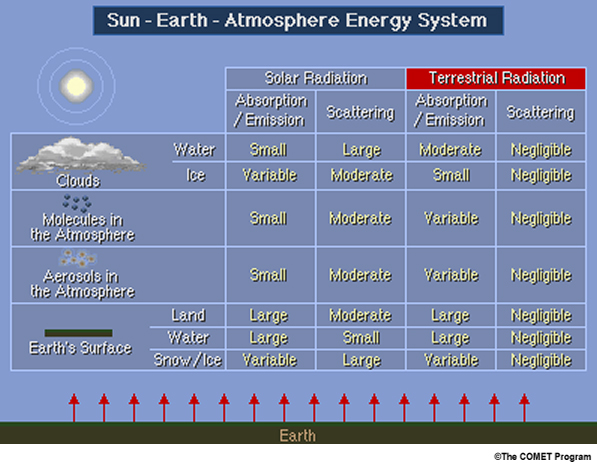Sun-Earth-Atmosphere Energy System
Table of Contents
Incoming Solar Energy
Incoming Solar Energy »Introduction
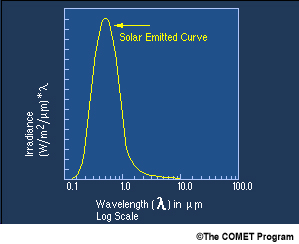
Ninety-nine percent of the incoming solar energy is at wavelengths of less than four Ám. The intensity peaks around 0.5 Ám, which is in the visible portion of the spectrum. This implies a source temperature of approximately 6000 K. No atmospheric phenomena generate this temperature.
Energy detected by the satellite at visible wavelengths is assumed to be ______ solar energy. Click on ALL of the choices that apply.
The correct answers are B and C.
The energy that is detected is either reflected or scattered solar energy. Absorbed energy can not be detected.
Incoming Solar Energy »Molecule Scattering and Absorption
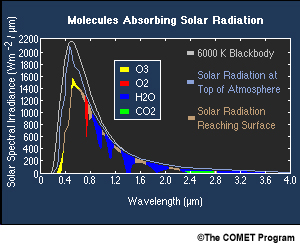
Through back-scattering into space and absorption, atmospheric gases and clouds decrease the amount of solar radiation reaching the earthĺs surface by about 50%. Some of the most common atmospheric gases are shown in the animation on the right. For example, molecular scattering creates the blue colour of the sky, and absorption and re-emission of radiation by ozone in the high atmosphere accounts for warming in the stratosphere.
Incoming Solar Energy »Reflected Solar Energy

Some solar energy is absorbed by the earth's surface, clouds, aerosols, and gases. A significant portion is also reflected or scattered back into space.
Incoming Solar Energy »Solar Scattering Early in the Day
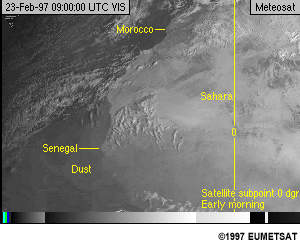
Scattering in various directions is controlled by the sun-target geometry and the physical characteristics of the scattering particles. In this example, a scattering pattern for aerosols is shown. Given the relative position of the sun and satellite in the diagram, only a small amount of visible energy is scattered toward the satellite. Hence, the aerosols are not readily detected by the satellite sensor.
Incoming Solar Energy »Solar Scattering at Mid-Day
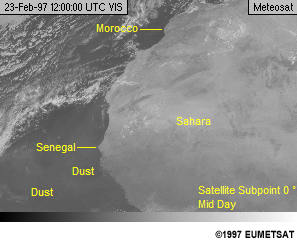
Given the relative position of the sun and satellite in this diagram, more visible light is scattered toward the satellite, although the majority of visible light is scattered toward the ground.
Incoming Solar Energy »Solar Scattering Late in the Day
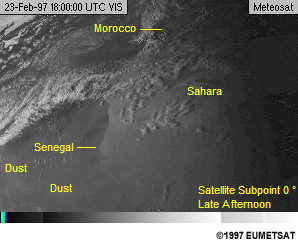
Given the relative position of the sun and satellite in this diagram, aerosols forward scatter more energy toward the satellite than at any other time of day, clearly revealing their presence.
The observed increase in brightness in the dust is caused by _______ scattering of radiation toward the satellite. Select the phrase that completes the sentence.
The correct answer is C.
The brightness increase is due to enhanced forward scattering by aerosols late in the day.
Incoming Solar Energy »Summary
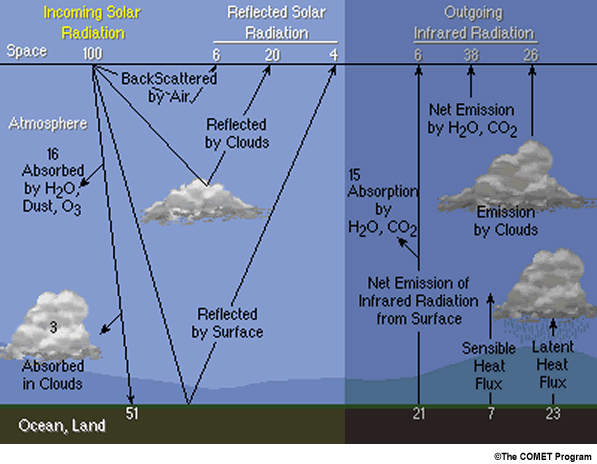
The graphic illustrates what happens to incoming solar radiation on a global scale. As solar radiation enters the atmosphere, it is absorbed by clouds and atmospheric constituents, back scattered by molecules and reflected by clouds, and reflected and absorbed at the earthĺs surface. The numbers on the graph provide an estimate of the global mean percentages of those processes.
Summary:
- Incoming solar radiation undergoes absorption and reflection by atmospheric constituents and the earth's surface
- In the atmosphere, molecules, aerosols, and clouds absorb 19% of the total incoming solar radiation
- At the earth's surface, land and ocean absorb 51%
- Air, clouds, and the earth's surface reflect 30% of the solar radiation back to space
- Any changes in absorption or reflection of solar radiation affects global temperatures
- The right side of the graphic is discussed in the next section (Earth Emitted Energy)
Earth Emitted Energy
Earth Emitted Energy »Absorption of Solar Energy
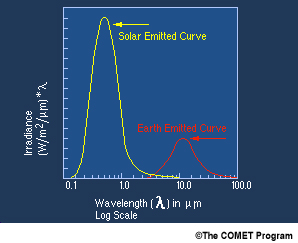
The earth's surface, clouds, and to a lesser extent atmospheric constituents, absorb solar energy. This energy is then re-emitted at infrared wavelengths. The amount of energy re-emitted is dependent on the temperature and emissivity of the earth's surface, clouds, aerosols, or gases.
Earth Emitted Energy » Earth Emitted (Thermal) Energy
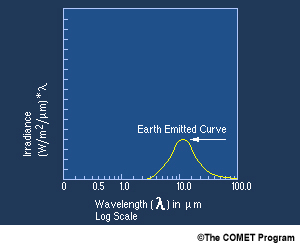
The earth and atmosphere emit primarily in the infrared region. Ninety-nine percent of that outgoing thermal energy is at wavelengths greater than 4 Ám, peaking near the 10 Ám wavelength. This wavelength region implies a source at approximately 290 K.
Earth Emitted Energy » Absorption Bands and Window Regions
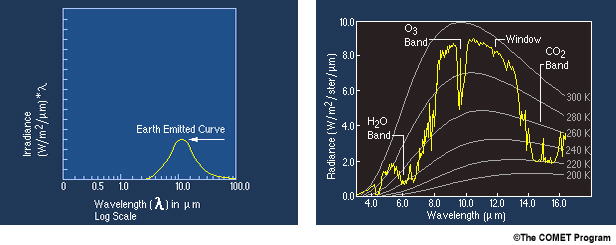
Although the earth emitted spectrum is shown as a smooth curve in the left graph, atmospheric gases absorb and then re-emit energy at discrete wavelengths. The graph on the right is the earth's emitted spectrum between 2 and 16 Ám with Planck curves at several temperatures superimposed. The yellow curve is earth emitted radiation in January 1995 from the Gulf of Mexico at 295 K. The upwelling radiance curve varies with wavelength due to absorption and emission by atmospheric gases at different pressure levels. The curve shows window regions as well as absorption bands.
Question 1
What happens to terrestrial energy in a window region? Click on your choice.
The correct answer is A.
A window region is a spectral range in which atmospheric constituents absorb little of the electromagnetic radiation directed toward the satellite.
Click on the second tab to answer Question 2.
Question 2
What happens to terrestrial energy in an absorption band? Click on your choice.
The correct answer is B.
An absorption band is a spectral range in which atmospheric constituents strongly attenuate electromagnetic radiation reaching a satellite.
Earth Emitted Energy » Thermal Energy Absorption by the Atmosphere
When thermal energy at wavelength λ encounters a molecule, that energy is either absorbed, scattered, or passes by without interaction, in other words transmitted.
The atmosphere generally behaves as a selective absorber and emitter. Gases absorb at some wavelengths and not others, because of the discrete vibrational and rotational states of the molecules involved in the absorption process. When radiation at a given wavelength interval is absorbed, it is re-emitted in all directions.
At wavelength λ, emissivity is defined as the ratio of the emitted radiance I(λ) to that of a black body, B(λ), at a given temperature.
To illustrate this, consider a water vapour molecule on the next page.
Earth Emitted Energy »Thermal Energy Absorption at 6.7 Ám
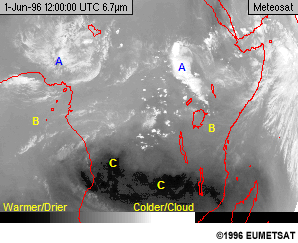
In the right panel, water vapour molecules are shown as they absorb and emit energy at 6.7 Ám. At this wavelength, water vapour very actively absorbs and re-emits radiation. Hence, energy emitted at 6.7 Ám from the earthĺs surface is absorbed and re-emitted by low level water vapour and does not reach the satellite. The energy detected by a sensor at 6.7 Ám comes from energy emitted at higher levels in the atmosphere. On the left is a Meteosat water vapour channel image showing mid and high level water vapour as grey regions (B) and high cloud tops as white (A); drier and/or warmer regions are dark (C).
Earth Emitted Energy » Thermal Energy Absorption at 11.5 Ám
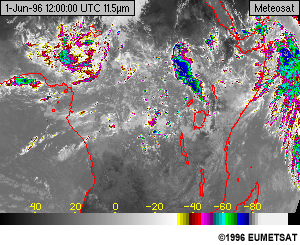
At 11.5 Ám, there is generally little interaction between radiation and water vapour. The image on the left shows the previous scene, but at 11.5 Ám. The colour bar on the bottom of the image indicates the observed brightness temperature. Notice that surface thermal features are apparent. When clouds are present, surface energy is absorbed, and the brightness temperature of the detected radiance is indicative of cloud top temperature.
Earth Emitted Energy » Conservation of Energy
Conservation of energy implies that radiation is either absorbed, reflected, or transmitted by a medium. The sum of these processes accounts for 100% of the energy.
Earth Emitted Energy »Summary
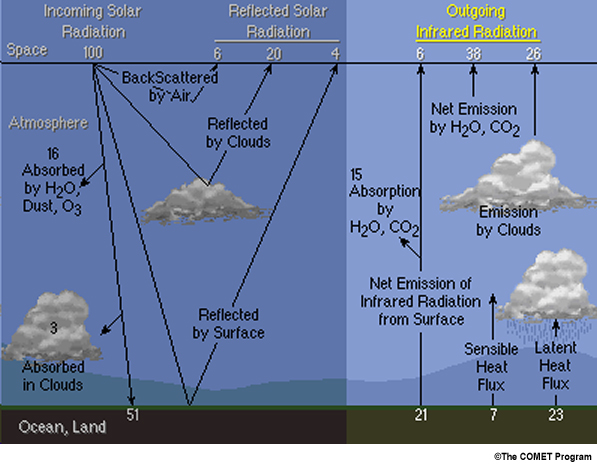
The graphic illustrates what happens to outgoing thermal radiation on a global scale. As earth emitted radiation enters the atmosphere, it is absorbed and re-emitted by clouds and atmospheric constituents. The numbers on the graph provide an estimate of the global mean percentages of those processes.
Summary:
- About 70% of the incoming solar radiation is absorbed by the earth surface and atmosphere and re-emitted as thermal radiation primarily in the infrared
- Outgoing infrared radiation is attenuated by atmospheric CO2, H2O, and O3
- The attenuation varies with wavelength; for example, an infrared window near 11.5 Ám sees the earth's surface, but the water vapour channel at 6.7 Ám sees only the upper half of the atmosphere
- Emission by atmospheric molecules and clouds accounts for most of the outgoing infrared radiation
- Sensible and latent heat flux, which vary greatly with location, redistribute 30% of the incoming solar energy
Summary
Summary »Summary
Click on any yellow text in the table for more information.
